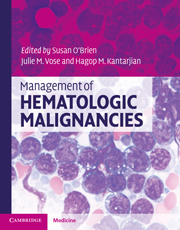Book contents
- Frontmatter
- Contents
- List of contributors
- 1 Molecular pathology of leukemia
- 2 Management of acute myeloid leukemia
- 3 Treatment of acute lymphoblastic leukemia (ALL) in adults
- 4 Chronic myeloid leukemia
- 5 Chronic lymphocytic leukemia/small lymphocytic lymphoma
- 6 Myelodysplastic syndromes (MDS)
- 7 Hairy cell leukemia
- 8 Acute promyelocytic leukemia: pathophysiology and clinical results update
- 9 Myeloproliferative neoplasms
- 10 Monoclonal gammopathy of undetermined significance, smoldering multiple myeloma, and multiple myeloma
- 11 Amyloidosis and other rare plasma cell dyscrasias
- 12 Waldenstrom's macroglobulinemia/lymphoplasmacytic lymphoma
- 13 WHO classification of lymphomas
- 14 Molecular pathology of lymphoma
- 15 International staging and response criteria for lymphomas
- 16 Treatment approach to diffuse large B-cell lymphomas
- 17 Mantle cell lymphoma
- 18 Follicular lymphomas
- 19 Hodgkin lymphoma: epidemiology, diagnosis, and treatment
- 20 Treatment approaches to MALT/marginal zone lymphoma
- 21 Peripheral T-cell lymphomas
- 22 Mycosis fungoides and Sézary syndrome
- 23 Central nervous system lymphoma
- 24 HIV-related lymphomas
- 25 Lymphoblastic lymphoma
- 26 Burkitt lymphoma
- Index
- References
11 - Amyloidosis and other rare plasma cell dyscrasias
Published online by Cambridge University Press: 10 January 2011
- Frontmatter
- Contents
- List of contributors
- 1 Molecular pathology of leukemia
- 2 Management of acute myeloid leukemia
- 3 Treatment of acute lymphoblastic leukemia (ALL) in adults
- 4 Chronic myeloid leukemia
- 5 Chronic lymphocytic leukemia/small lymphocytic lymphoma
- 6 Myelodysplastic syndromes (MDS)
- 7 Hairy cell leukemia
- 8 Acute promyelocytic leukemia: pathophysiology and clinical results update
- 9 Myeloproliferative neoplasms
- 10 Monoclonal gammopathy of undetermined significance, smoldering multiple myeloma, and multiple myeloma
- 11 Amyloidosis and other rare plasma cell dyscrasias
- 12 Waldenstrom's macroglobulinemia/lymphoplasmacytic lymphoma
- 13 WHO classification of lymphomas
- 14 Molecular pathology of lymphoma
- 15 International staging and response criteria for lymphomas
- 16 Treatment approach to diffuse large B-cell lymphomas
- 17 Mantle cell lymphoma
- 18 Follicular lymphomas
- 19 Hodgkin lymphoma: epidemiology, diagnosis, and treatment
- 20 Treatment approaches to MALT/marginal zone lymphoma
- 21 Peripheral T-cell lymphomas
- 22 Mycosis fungoides and Sézary syndrome
- 23 Central nervous system lymphoma
- 24 HIV-related lymphomas
- 25 Lymphoblastic lymphoma
- 26 Burkitt lymphoma
- Index
- References
Summary
Introduction
The spectrum of plasma cell disorders is vast. From a proliferation standpoint, the spectrum extends from the premalignant monoclonal gammopathy of undetermined significance (MGUS) to multiple myeloma, to plasma cell leukemia. The picture, however, is much more complex because there are also low tumor burden and low proliferation plasma cell diseases responsible for a clinical phenotype ranging from troublesome to fatal. These conditions are rare, but must be recognized in order to reduce morbidity and mortality. For most of these diseases, the pathogenesis is not well understood.
The discussion will begin with the three more common and potentially life-threatening disorders, light chain amyloidosis (AL), POEMS syndrome (polyradiculoneuropathy, organomegaly, endocrinopathy, monoclonal protein, skin changes), and cryoglobulinemia. Subsequently, the monoclonal gammopathy-associated disease entities will be parsed according to their dominant clinical feature – neuropathy, dermopathy, and nephropathy – and will include: MGUS-associated peripheral neuropathy, scleromyxedema, xanthogranulosum necrobiotica, and Schnitzler's syndrome.
Immunoglobulin light chain amyloidosis
Immunoglobulin light chain amyloidosis (AL) is a low tumor burden plasma cell disorder characterized by deposition of insoluble fibrils composed of immunoglobulin light chains. Without treatment, it has an inexorable progressive course due to uncontrolled tissue damage. Not all amyloidosis is related to a plasma cell dyscrasia. Although AL is the most common form of systemic amyloidosis, with an incidence of approximately 1 case per 100,000 person-years in Western countries, there are other forms of systemic amyloidosis as well (Table 11.1).
- Type
- Chapter
- Information
- Management of Hematologic Malignancies , pp. 184 - 206Publisher: Cambridge University PressPrint publication year: 2010



